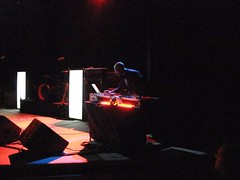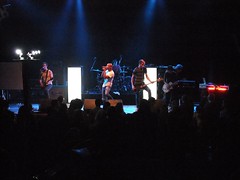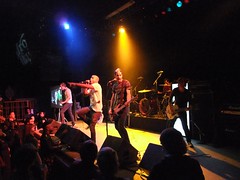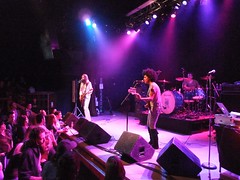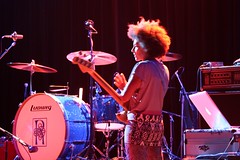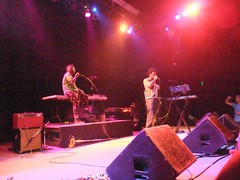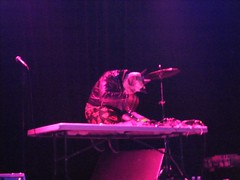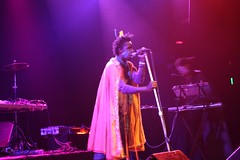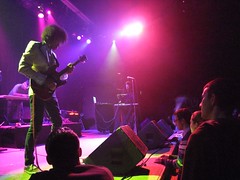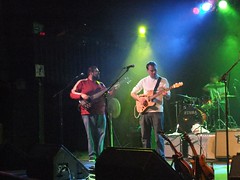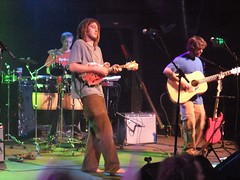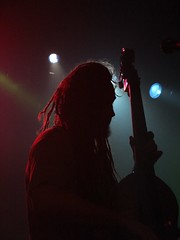 This show promised something familiar and something new. Jill Sobule was here in July with John Doe and the Sadies, but I hadn't seen Erin McKeown before. It became clear that the two of them have developed a good tour chemistry.
This show promised something familiar and something new. Jill Sobule was here in July with John Doe and the Sadies, but I hadn't seen Erin McKeown before. It became clear that the two of them have developed a good tour chemistry.The Walnut Room is an interesting venue. It has a normal bar with seating out front and a fairly intimate performance room in the back. With a scattering of tables and not much open space in front of the stage, a more raucous crowd wouldn't have fit. Last night, though, this wasn't a problem. The audience was enthusiastic, but fairly polite.
Jill and Erin kicked off the show together, singing a one-off theme song for Denver. It was a good start, reminding the crowd that Jill is a home town girl. Her set list ran through familiar paths, with several songs from California Years. As I've come to expect, Jill brought an uncompromising sincerity along with a slight vulnerability to her songs that built a strong connection to the audience.
Erin sat in on a few songs, adding a nice electric lead touch to Where is Bobbie Gentry? and a Riders on the Storm-influenced low-key organ backing for When My Ship Comes In. This last was probably my favorite song of the set. Jill was loose and funky with the rhythm; the song had a really fresh feel. Jill's friend, Eric Moon, also sat in on accordion for several songs -- another nice local touch.

In a lighter moment, Jill reworked her Kathie Lee song of a hidden lesbian relationship to take aim at Condoleezza Rice. This served as the perfect sweetness before her last song, Sonny Liston, which captured an aching sense of nostalgia and loss.
Erin McKeown
 I recently reviewed Hundreds of Lions, McKeown's latest CD. It's a great listen, but how well would it translate to a stripped down solo performance? It turned out that the live energy and stage presence easily made up for the missing musical parts of a fuller band.
I recently reviewed Hundreds of Lions, McKeown's latest CD. It's a great listen, but how well would it translate to a stripped down solo performance? It turned out that the live energy and stage presence easily made up for the missing musical parts of a fuller band.
 I recently reviewed Hundreds of Lions, McKeown's latest CD. It's a great listen, but how well would it translate to a stripped down solo performance? It turned out that the live energy and stage presence easily made up for the missing musical parts of a fuller band.
I recently reviewed Hundreds of Lions, McKeown's latest CD. It's a great listen, but how well would it translate to a stripped down solo performance? It turned out that the live energy and stage presence easily made up for the missing musical parts of a fuller band.With no break between sets, Erin dove right into a sing-along version of Slung-Lo. Acting out the lines to teach the audience, McKeown was playful and fun. Then she shifted into an up tempo rockabilly vibe for Queen of Quiet. Then came the bluesy groove of The Taste of You, complete with the lead in story about living across from a strip club.

From song to song, including several from Hundreds of Lions, it was clear that the crowd knew the material well. The mood evolved throughout the set, but Erin's warm interactions with the audience were constant.
Jill Sobule returned the favor from her set and sat in on several songs. Their styles were so different, yet complementary. They ended with a huge encore of Neil Diamond's America, which had both women competing on who could channel Neil the best (I'd give it to Erin). The crowd joined in and closed out the night on a great show.
The Black and Tans I had were the perfect match for the music: two contrasting parts that fit well together.
Many more pictures at my Flickr.






